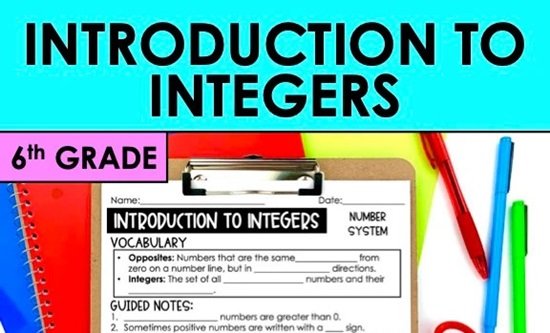
Chapter 6: Integers ( Best Solution )
Chapter 6: Integers- Mathematics
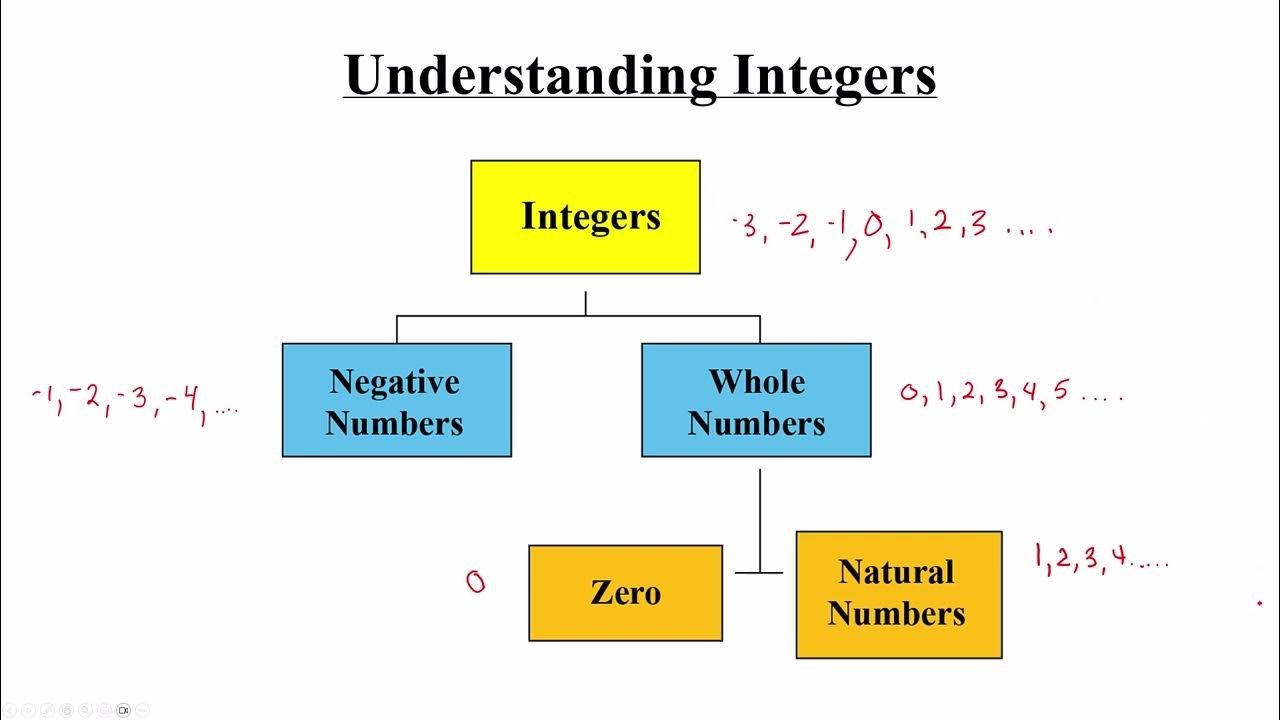
Integers:
Whole Numbers
Whole numbers include zero and all natural numbers i.e. 0, 1, 2, 3, 4, and so on.
The whole numbers are the numbers without fractions and it is a collection of positive integers and zero. It is represented by the symbol “W” and the set of numbers are {0, 1, 2, 3, 4, 5, 6, 7, 8, 9,……………}. Zero as a whole represents nothing or a null value.
- Whole Numbers: W = {0, 1, 2, 3, 4, 5, 6, 7, 8, 9, 10……}
- Natural Numbers: N = {1, 2, 3, 4, 5, 6, 7, 8, 9,…}
- Integers: Z = {….-9, -8, -7, -6, -5, -4, -3, -2, -1, 0, 1, 2, 3, 4, 5, 6, 7, 8, 9,…}
- Counting Numbers: {1, 2, 3, 4, 5, 6, 7,….}
These numbers are positive integers including zero and do not include fractional or decimal parts (3/4, 2.2 and 5.3 are not whole numbers). Addition, Subtraction, Multiplication and Division operations are possible on whole numbers.
Symbol
The symbol to represent whole numbers is the alphabet ‘W’ in capital letters.
W = {0, 1, 2, 3, 4, 5, 6, 7, 8, 9, 10,…}
Thus, the whole numbers list includes 0, 1, 2, 3, 4, 5, 6, 7, 8, 9, 10, 11, 12, ….
Facts:
- All the natural numbers are whole numbers
- All counting numbers are whole numbers
- All positive integers including zero are whole numbers
- All whole numbers are real numbers
Whole Numbers Properties
The properties of whole numbers are based on arithmetic operations such as addition, subtraction, division and multiplication. Two whole numbers if added or multiplied will give a whole number itself. Subtraction of two whole numbers may not result in whole numbers, i.e. it can be an integer too. Also, division of two whole numbers results in getting a fraction in some cases. Now, let us see some more properties of whole numbers and their proofs with the help of examples here.
Closure Property
They can be closed under addition and multiplication, i.e., if x and y are two whole numbers then x. y or x + y is also a whole number.
Example:
5 and 8 are whole numbers.
5 + 8 = 13; a whole number
5 × 8 = 40; a whole number
Therefore, the whole numbers are closed under addition and multiplication.
Commutative Property of Addition and Multiplication
The sum and product of two whole numbers will be the same whatever the order they are added or multiplied in, i.e., if x and y are two whole numbers, then x + y = y + x and x.y = y.x
Example:
Consider two whole numbers 3 and 7.
3 + 7 = 10
7 + 3 = 10
Thus, 3 + 7 = 7 + 3.
Also,
3 × 7 = 21
7 × 3 = 21
Thus, 3 × 7 = 7 × 3
Therefore, the whole numbers are commutative under addition and multiplication.
Additive identity
When a whole number is added to 0, its value remains unchanged, i.e., if x is a whole number then x + 0 = 0 + x = x
Example:
Consider two whole numbers 0 and 11.
0 + 11 = 0
11 + 0 = 11
Here, 0 + 11 = 11 + 0 = 11
Therefore, 0 is called the additive identity of whole numbers.
Multiplicative identity
When a whole number is multiplied by 1, its value remains unchanged, i.e., if x is a whole number then x.1 = x = 1.x
Example:
Consider two whole numbers 1 and 15.
1 × 15 = 15
15 × 1 = 15
Here, 1 × 15 = 15 = 15 × 1
Therefore, 1 is the multiplicative identity of whole numbers.
Associative Property
When whole numbers are being added or multiplied as a set, they can be grouped in any order, and the result will be the same, i.e. if x, y and z are whole numbers then x + (y + z) = (x + y) + z and x. (y.z) = (x.y). z
Example:
Consider three whole numbers 2, 3, and 4.
2 + (3 + 4) = 2 + 7 = 9
(2 + 3) + 4 = 5 + 4 = 9
Thus, 2 + (3 + 4) = (2 + 3) + 4
2 × (3 × 4) = 2 × 12 = 24
(2 × 3) × 4 = 6 × 4 = 24
Here, 2 × (3 × 4) = (2 × 3) × 4
Therefore, the whole numbers are associative under addition and multiplication.
Distributive Property
If x, y and z are three whole numbers, the distributive property of multiplication over addition is x. (y + z) = (x.y) + (x.z), similarly, the distributive property of multiplication over subtraction is x. (y – z) = (x.y) – (x.z)
Example:
Let us consider three whole numbers 9, 11 and 6.
9 × (11 + 6) = 9 × 17 = 153
(9 × 11) + (9 × 6) = 99 + 54 = 153
Here, 9 × (11 + 6) = (9 × 11) + (9 × 6)
Also,
9 × (11 – 6) = 9 × 5 = 45
(9 × 11) – (9 × 6) = 99 – 54 = 45
So, 9 × (11 – 6) = (9 × 11) – (9 × 6)
Hence, verified the distributive property of whole numbers.
Multiplication by zero
When a whole number is multiplied to 0, the result is always 0, i.e., x.0 = 0.x = 0
Example:
0 × 12 = 0
12 × 0 = 0
Here, 0 × 12 = 12 × 0 = 0
Thus, any whole number multiplied by 0, the result is always 0.
Division by zero
Division of a whole number by o is not defined, i.e., if x is a whole number, then x/0 is not defined.
Numbers on a Number Line
Arithmetic operations of numbers can be better explained on a number line. To begin with, one must know to locate numbers on a number line. Zero is the middle point of a number line. All (natural numbers) positive numbers occupy the right side of the zero whereas negative numbers occupy the left side of zero on the number line. As we move on to the left side value of a number decreases. For example, 1 is greater than -2. In a number line, integers, fractions, and decimals can also be represented easily. Check out the links given below to learn more.
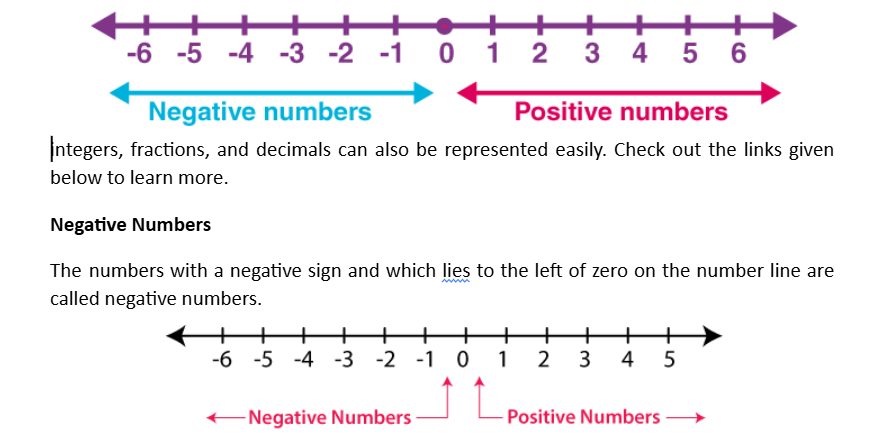
Applications of Negative Numbers in Real Life
Irrespective of their value, they have a broad connection to daily life. These numbers are widely used in different fields. Some of the real-life examples are given below.
Finance and Banking
Banking and financing are all about money, credit and debit. Hence, we need some numbers which can differentiate a credit amount from the debit amount. Another instance is profit and loss. These all are mathematically denoted by using positive and negative integers. If someone debited to someone it is represented by a minus sign. The stock market is another field which widely uses negative integers to show its share price and ups and downs.
Science
Use of negative numbers is commonly observed in weather broadcasting. Thermometers are vertical number lines which measure the temperature of a body as well as the temperature of an area. Meteorologist uses negative numbers to show the cold condition of a region like -15˚C. Even when the body temperature goes down a negative integer is used to represent the condition. Temperature below zero denoted with the negative sign while a temperature above zero denoted with the positive sign. Other instruments and conditions that depend on integers are batteries, blood pressure, overweight and underweight, drug testing and so on.
Other Applications
In sports, the goal differences in games like hockey, football are denoted by integers. Other examples are the speed of a car, the rating of songs or movies, the numbering of a story of a building, etc.
Introduction to Zero
The number Zero
The number zero means an absence of value.
The Number Line
Integers
Collection of all positive and negative numbers including zero are called integers. ⇒ Numbers …, – 4, – 3, – 2, – 1, 0, 1, 2, 3, 4, … are integers.
Representing Integers on the Number Line
- Draw a line and mark a point as 0 on it
- Points marked to the left (-1, -2, -3, -4, -5, -6) are called negative integers.
- Points marked to the right (1, 2, 3, 4, 5, 6) or (+1, +2, +3, +4, +5, +6) are called positive integers.
Absolute value of an integer
- Absolute value of an integer is the numerical value of the integer without considering its sign.
- Example: Absolute value of -7 is 7 and of +7 is 7.
Ordering Integers
- On a number line, the number increases as we move towards right and decreases as we move towards left.
- Hence, the order of integers is written as…, –5, –4, – 3, – 2, – 1, 0, 1, 2, 3, 4, 5…
- Therefore, – 3 < – 2, – 2 < – 1, – 1 < 0, 0 < 1, 1 < 2 and 2 < 3.
Addition of Integers
Positive integer + Negative integer
Example: (+5) + (-2) Subtract: 5 – 2 = 3 Sign of bigger integer (5): + Answer: +3
Example: (-5) + (2) Subtract: 5-2 = 3 Sign of the bigger integer (-5): – Answer: -3
Positive integer + Positive integer
Example: (+5) + (+2) = +7
Add the 2 integers and add the positive sign.
Negative integer + Negative integer
Example: (-5) + (-2) = -7
Add the two integers and add the negative sign.
Properties of Addition and Subtraction of Integers
Operations on Integers
Operations that can be performed on integers:
- Addition
- Subtraction
- Multiplication
- Division.
Subtraction of Integers
The subtraction of an integer from another integer is same as the addition of the integer and its additive inverse.
Example: 56 – (–73) = 56 + 73 = 129 and 14 – (8) = 14 – 8 = 6
Properties of Addition and Subtraction of Integers
Closure under Addition
a + b and a – b are integers, where a and b are any integers.
Commutativity Property
a + b = b + a for all integers a and b.
Associativity of Addition
(a + b) + c = a + (b + c) for all integers a, b and c.
Additive Identity
Additive Identity is 0, because adding 0 to a number leaves it unchanged.
a + 0 = 0 + a = a for every integer a.
Multiplication of Integers
- Product of a negative integer and a positive integer is always a negative integer. 10 × − 2 = −20
- Product of two negative integers is a positive integer. −10 × −2 = 20
- Product of even number of negative integers is positive. (−2) × (−5) = 10
- Product of an odd number of negative integers is negative. (−2) × (−5) × (6) = −60
Properties of Multiplication of Integers
Closure under Multiplication
Integer × Integer = Integer
Commutativity of Multiplication
For any two integers a and b, a × b = b × a.
Associativity of Multiplication
For any three integers a, b and c, (a × b) × c = a × (b × c).
Distributive Property of Integers
Under addition and multiplication, integers show the distributive property.
For any integers a, b and c, a × (b + c) = a × b + a × c.
Multiplication by Zero
For any integer a, a × 0 = 0 × a = 0.
Multiplicative Identity
1 is the multiplicative identity for integers.
a × 1 = 1 × a = a
Division of Integers
(positive integer/negative integer) or (negative integer/positive integer)
⇒ The quotient obtained is a negative integer.
(positive integer/positive integer) or (negative integer/negative integer)
⇒ The quotient obtained is a positive integer.
Properties of Division of Integers
For any integer a,
- a/0 is not defined
- a/1=a
Integers are not closed under division.
Example: (–9) ÷ (–3) = 3 result is an integer but (−3) ÷ (−9) = −3 −9 = 13 = 0.33 which is not an integer.
To know more about Number Lines,
Important Questions
Multiple Choice questions:
- Write numbers with appropriate signs: 40°C below 0°C temperature.
- 30
- 40
- -40
- None of these
- 2 subtracted from 7 gives
- -5
- 5
- -9
- 9
- Fill in the blanks with >, < or = sign. (- 3) + (- 6) ______ (- 3) – (- 6)
- <
- >
- None of these
- =
- The number of integers between -2 and 2 is:
- 3
- 5
- 4
- 2
- Sum of (- 9) and 15.
- 90
- -6
- 6
- 20
- o is:
- a positive integer
- a negative integer
- neither positive nor negative
- none of these
- What is opposite of ’50 km of south’?
- 50 km of east
- 50 km of west
- 50 km of north
- None of these
- Sum of – 30 and – 12 is:
- -42
- 42
- -18
- 18
- Compare pairs of numbers using > or <: 0 _____ -15.
- <
- =
- >
- None of these
- 10 – (-6) is:
- 16
- 4
- 60
- 6
- What must be added to -35 to get 35?
- 40
- 70
- 0
- 100
- The absolute value of -10 is:
- -10
- 10
- -11
- -9
- Absolute value of – 11 is:
- 0
- 11
- 1
- -11
- Product of -140 and +8 is:
- 1120
- 3200
- −1120
- −3200
- (– 4) + (+ 3) = _____
- 7
- -1
- 6
- None of these
Match The Following:
| Column I | Column II | ||
|---|---|---|---|
| 1. | 10 steps to the right | A. | 1000 |
| 2. | 10 km below sea level | B. | 1000 |
| 3. | Deposit Rs. 1000 in a bank | C. | 10 |
| 4. | Spending Rs. 1000 | D. | 10 |
Fill in the blanks:
- When we subtract -10 from 18 we get ______.
- _____ is an integer which is neither positive nor negative.
- 272 – 198 – ______ = 0.
- 15 + _____ =0
True /False:
- If a and b are any two integers such that a > b, then -a > – b.
- If the sum of an integer and its opposite is zero, then they are called additive inverses of each other.
- The negative of 0 is -0.
- The sum of positive and negative integers is always negative.
Very Short Questions:
- Write four negative integers less than -20.
- Write all the integers between -8 and -15. (Write them in the increasing order.)
- Find the solution of the following:(-9) + (+13)
- Subtract: (-20) – (-13)
- Find the value of:(-7) + (-9) + 4 + 16
- Using number line, add the following integers: 9 + (-6).
- The temperature on a certain morning is -11℃ at 5 a. m. If the temperature drops 3 degree at 6 a.m. and rises 5 degree at 8 a.m. and again drops 3 degree at 9 a.m. What is the temperature at 9 a.m.?
- Represent the following on number line:
(a) -5
(b) 4
- Identify the negative integers from the given numbers.
– 5, 3, 0, 5, – 6, 7, 3, 4, – 4, – 7
- What is the additive identity of – 20?
Short Questions:
- Write the following integers in their increasing order.
– 3, 0, – 6, 5, – 4, 6, 3, – 8
- Comparing the following pairs of number use > or < .
- Write all the integers between the following pair of integers:
(а) 0 and – 4
(B) – 5 and 5
(c) – 8 and – 13
(d) 3 and 6
- Find the solution of the following additions using number line:
(a)(- 3) + 5
(B) (- 5) + (-2)
- Find the sum of the following integers:
(a) (- 8) + (+ 5) + (- 3) + (- 2)
(B) (- 7) + (- 9) + (+ 4) + (+ 3)
Long Questions:
- Ramesh thinks of an integer. He subtracts 12 from it and gets the result as – 6. What was the integer he thought of?
- Determines:
(a) |5| – |- 3|
(b) |5 – 6|+ |-1|
(c) – 7 + |– 3|
(d) |5| + |– 12|
- If * is an operation such that for two integers p and q, p * q = p + q – 2, then find:
(a) 6 * 2
(b) (- 2) * (- 3)
(c) (- 2) * (4)
(d) (+ 3) * (- 1)
Assertion and Reason Questions:
1.) Assertion (A) – David and Mohan have started walking from zero position inopposite directions. Let the steps to the right of zero be represented by ‘+’sign and to the left of zero represented by ‘–’ sign. If Mohan moves 5 stepsto the right of zero it can be represented as +5 and if David moves 5 steps tothe left of zero it can be represented as – 5.
Reason (R) – a movement to the right is made if the number by which we have to move is positive and A movement to the left is made if the number by which the token has tomove is negative.
- a) Both A and R are true and R is the correct explanation of A
- b) Both A and R are true but R is not the correct explanation of A
- c) A is true but R is false
- d) A is false but R is true
2.) Assertion (A) – The first numbers to be discovered were natural numbers i.e. 0,1, 2, 3, 4,…
Reason (R) – this collection of numbers is known as Integers
- a) Both A and R are true and R is the correct explanation of A
- b) Both A and R are true but R is not the correct explanation of A
- c) A is true but R is false
- d) A is false but R is true
ANSWER KEY –
Multiple Choice questions:
- C. -40
Explanation: below means less than 0 so it is – 40
- B. 5
Explanation: 7 – 2 = 5
- A. <
Explanation: -3 -6 = -9
-3 – (-6) = – 3 + 6 = 6 – 3 = 3
so – 9 < 3
- A. 3
Explanation: integers between -2 and 2 are -1,0, 1 so 3 integers
- C. 6
Explanation: -9 + 15 = 15 – 9 = 6
- C. neither positive nor negative
- C. 50 km of north
- A. -42
- C. >
- A. 16
- B. 70
- B. 10
- B. 11
- C. −1120
- B. -1
Match The Following:
| Column I | Column II | ||
|---|---|---|---|
| 1. | 10 steps to the right | C. | 10 |
| 2. | 10 km below sea level | D. | 10 |
| 3. | Deposit Rs. 1000 in a bank | B. | 1000 |
| 4. | Spending Rs. 1000 | A. | 1000 |
Fill in the blanks:
- When we subtract -10 from 18 we get 28.
- 0 is an integer which is neither positive nor negative.
- 272 – 198 – 74 = 0.
- 15 + -15 =0
True /False:
- False
- True
- False. zero is neither negative nor positive
- False
Very Short Answer:
- Four negative integers less than -20 are -21, -22, -23 and -24.
- The integers between -8 and -15 in increasing order are -14, -13, -12, -11, -10 and -9.
- (-9) + (+13)
= (-9) + (+9) + (+4)
= 0 + (+4) = +4
- (-20) – (-13)
= (-20) + (additive inverse of -13)
= (-20) + (13) = -7
- (-7) + (-9) + 4 + 16
= (-16) + 20
= (-16) + 16 + 4
= 0 + 4 = 4
- On the number line we first move 9 steps to the right from 0 reaching 9 and then we move 6 steps to the left of 9 and reach 3.
Thus, 9 + (-6) = 3
- Temperature at 5 a.m. = -11℃
Temperature decreased at 6 a.m. = 3℃ = -3
Temperature raised at 8 a.m. = 5℃ = +5
Temperature decreased at 9 a.m. = 3℃ = -3
Final temperature at 9 a.m. = (-11) + (-3) + (+5) + (-3)
= -11 – 3 + 5 – 3
= -17 + 5
= -12℃.
- (a) – 5
(b) 4
- Negative integers are – 5, – 6, – 4 and – 7 .
- Additive identity of – 20 is 20.
Short Answer:
- The required increasing order is:
– 8, – 6, – 4, – 3, 0, 3, 5, 6
- (a) 0 > – 6
(b) – 10 < – 2
(c) – 100 < 100
(d) 2 > – 2
- (a) Integers between 0 and – 4 are: -3, -2, -1
(B) Integers between – 5 and 5 are: -4, -3, -2, -1, 0, 1, 2, 3, 4.
(c) Integers between – 8 and – 13 are: -12, -11, -10, -9
(d) Integers between 3 and 6 are: 4 and 5
- (a)(- 3) + 5
∴ (-3) + 5 = 2
(B) (- 5) + (-2)
∴ (-5) + (-2) = (-7)
- (a) (- 8) + (+ 5) + (- 3) + (- 2)
= (- 8) + (+ 5) – (3 + 2)
= (- 8) + (+ 5) – (5)
= (- 8) + 0 = – 8 [ ∵ (+ a) + (- a) = 0]
(b) (- 7) + (- 9) + (+ 4) + (+ 3)
= (- 7) + (- 9) + (4 + 3)
= (- 7) + (- 9) + (+ 7)
= (- 7) + (+ 7) + (- 9)
= 0 + (- 9) = – 9 [ ∵ (- a) + (+ a) = 0]
Long Answer:
- The given sum can be written as under.
(___) – (12) = – 6
The required integer is 12 – 6 = 6.
- (a) | 5 | – | – 3 | = 5 – 3 = 2 [∵ |a| = a and |- a| = a]
(b) |5 – 6 | + |- 1| = |- 1| + |-1| = 1 + 1 = 2
(c) – 7 + |– 3| = -7 + 3 = -4
(d) |5| + |– 12| = 5 + 12 = 17
- (a) Given that: p * q = p + q – 2
⇒ 6 * 2 = 6 + 2 – 2 = 6 + 0 = 6
Thus, 6 * 2 = 6.
(b) Given that: p * q = p + q – 2
⇒ (- 2) * (- 3) = (- 2) + (- 3) – 2
= -5 – 2 = -7.
Thus, (- 2) * (- 3) = – 7.
(c) Given that: p * q = p + q – 2
⇒ (- 2) * (4) = (- 2) + (4) – 2 = 2 – 2 = 0.
Thus, (- 2) * (4) = 0.
(d) Given that p*q – p + q – 2
⇒ (+ 3) * (- 1) = (+ 3) + (- 1) – 2 = 2 – 2 = 0
Thus, (+ 3) * (- 1) = 0.
Assertion and Reason Answers:
1) a) Both A and R are true and R is the correct explanation of A
2) d) A is false but R is true
Download PDF Notes and Excercise solution of the Chapter.

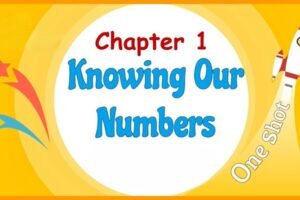
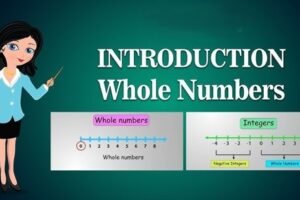

1 Comment